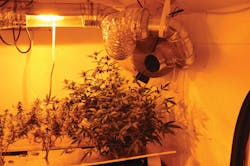Hazmat Sidebar: Fire-EMS Response to Indoor Marijuana Grows
An indoor marijuana grow is an illegal operation where the plants are grown or engineered to maturity and sold or the concentrated resin (hashish oil) is extracted from them. These operations can range from very simple to extremely complex. Marijuana grow houses are structures, often urban residences and rental properties, converted for the purpose of growing marijuana. It is important to remember that first responders have been injured at these locations.
Law enforcement operations involving indoor marijuana grows have the potential to escalate into hazardous materials, fire or EMS responses. If your fire-EMS agency is dispatched to a possible indoor marijuana grow, would you know how to recognize one? What would happen if you found one? Who would you call for assistance?
Warning Signs
Warning signs for fire and EMS responders that a location possibly houses an indoor marijuana grow include:
- Security. Unusually high numbers of “Keep Out” or “Beware of Dogs” signs may be present. High fences, locked gates, and heavy chains and locks may also be visible.
- Smell. Indoor marijuana grows produce a heavy odor of marijuana that can be recognized outside the location. Growers may attempt to camouflage the smell with other products.
- Condensation. Humidity in growing rooms can reach as much as 100%, producing large amounts of condensation on windows.
- Lights. High-intensity lamps are used in indoor grows. High-intensity light can be seen around doors or windows. The building may appear much brighter than surrounding houses. This can lead to a severe fire hazard.
- Covered windows. Windows may be covered with black plastic or heavy curtains or drapes that are closed tight and pressed against the windows. This is to prevent light from escaping and to keep natural light from disrupting artificial light cycles.
- Open windows. Windows may be cracked open during winter to cool the house and grow room due to excess heat from high-intensity lighting.
- Excess air conditioning units. Look for a small house with more air conditioners than would usually be needed to cool that size home and units running during winter or other periods of cooler temperatures.
These indicators are not proof that you have found an indoor marijuana growing operation, but they should raise a red flag for responders.
Fire-EMS Hazards
Hazards emergency responders may encounter at an indoor marijuana grow include:
- Violence. Criminals who want to steal the large amounts of cash available or the profitable plants themselves have targeted indoor growing operations. This has prompted growers to arm themselves or place booby traps to protect their investments. These present a risk factor for responders.
- Fire. Fire hazards have included exposed live wires, wire bundles, wires exposed to water or in contact with water and large numbers of high-intensity light bulbs. Also, grows may use several extra exhaust fans, which can further the spread of a fire. Numerous indoor grows have been discovered due to fires.
- Atmospheric. One of the greatest hazards can be an oxygen-deficient atmosphere. Any atmosphere with an oxygen concentration below 19.5% or above 23.5% is dangerous. Carbon dioxide (CO2) is often artificially introduced to the indoor grow area to assist with plant growth. Flammable gas, vapor or mist in excess of 10% of its lower flammable limit (LFL) also is a hazard. Ozone (O3) generators are commonly used to reduce or eliminate the odor of an indoor grow; ozone is a known carcinogen.
- Electrical. A residence in which an indoor grow is operating can use three to 10 times the power of an average residence. Growers will attempt to bypass the normal distribution of power and steal additional power for their operations. Those with little or no understanding of electricity typically attempt a bypass and this can create very unsafe conditions and a fire hazard. Ballasts used to run high intensity grow lights can maintain a charge for up to 15 minutes after being unplugged. Hydroponic grows combine two incompatibles – water and electricity. Numerous firefighters and law enforcement officers have been electrocuted at indoor grows.
- Environmental. Molds present a health hazard at an indoor marijuana grow. Without respiratory protection, such mold exposure can cause allergic reactions, sinus and respiratory distress, even death in some cases. Large amounts of fungicides, pesticides, insecticides, acids and bases are stored and disposed of improperly, including being poured down drains and sewers.
- Structural factors. Homes used for indoor marijuana grows can be altered to produce the maximum growing environment for the plants and to disguise the growing location. Walls will be moved to make room. High levels of humidity will lead to growth of dangerous fungus and molds, causing damage to insulation, walls and ceilings. Some grows have been discovered in underground rooms and tunnels. These are considered confined spaces and must be dealt with as such. Occupational Safety and Health Administration (OSHA) guidelines must be followed and only those properly trained may act as an entrant, attendant or confined-space supervisor. No other persons can make entry into this environment.
- Hazardous materials. Many extraction techniques use flammable and volatile solvents. These can include acetones, camp fuel and isopropyl alcohol. These grows may produce many large garbage bags that are dumped illegally off site.
In addition to the chemical and process hazards at indoor marijuana grows, responders must be aware of anti-personnel devices (APDs) placed as booby traps. These devices are sometimes designed to protect the grow owners’ investment while they are away and to serve as warning devices to aid in the owners’ or operators’ escape. Unfortunately, they can also incapacitate first responders. DO NOT ATTEMPT TO MOVE, HANDLE OR DISARM A CONFIRMED OR SUSPECTED APD. THIS IS A JOB FOR TRAINED PERSONNEL.
Response Guidelines
Preparation is the key and that includes a clear idea of your actions before the incident or operation occurs. The first step in preparation is providing proper training to all response personnel. This should include identification of indoor marijuana grows and an awareness of the risks associated with them. Growing operations been discovered in locations that include attics, basements, apartments, storage units, barns, underground locations and confined spaces.
- If an indoor marijuana grow is suspected during routine fire-EMS calls, local law enforcement should be alerted immediately and the area secured
- Firefighters may need to provide law enforcement with breathing equipment or other tools and supplies
- Attempting to control a structural fire may be very hazardous to the fire attack team
- If an initial fire attack is in progress when the location is identified as a large growing operation, withdraw the attack teams and shift from an offensive to a defensive operation
- Discontinue overhaul and leave the structure if chemicals, plants and/or drug apparatus are found
- Decontamination considerations before any entry, especially in case of a responder emergency, must be thought out carefully and focused on hasty or emergency decontamination procedures
- If a drug lab is found upon entry into a structure, alert other responders on scene without delay and do not touch anything, including light switches, then back out immediately, watch for anti-personnel devices and other hazards and, if possible, bring all occupants out with you
- Fire-EMS responders must use care when interacting with growers – remember, you may have also happened upon a crime scene
If your jurisdiction has a hazardous material response team, it may need to be called to the scene to assist with decontamination and set up control zones. Upon the team’s arrival, brief the members about your findings and actions, and support and assist them as needed.
Additional precautions include:
- DO NOT touch anything in the grow
- DO NOT turn on any electrical power switches or light switches
- DO NOT turn off any electrical power switches or light switches
- DO NOT eat or drink in or around a grow
- DO NOT open or move containers with chemicals or suspected chemicals
- DO NOT smoke in or near a grow
- DO NOT sniff any containers
- DO decontaminate yourself and your clothing
- DO wash your hands and face thoroughly
- DO call your local law enforcement as soon as possible
—August Vernon
About the Author

August Vernon
AUGUST VERNON is the operations officer for the Forsyth County Office of Emergency Management in Winston-Salem, NC. He served in the U.S. Army as a chemical, biological, radiological and nuclear (CBRN) operations specialist. He is a writer and member of the International Fire Service Training Association (IFSTA) WMD/Terrorism Committee. Vernon is the author of the new First Responders Critical Incident Guide published by Red Hat Publishing.
